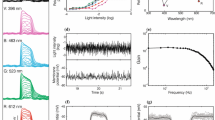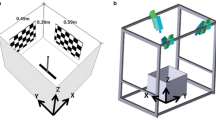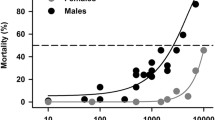Abstract
As shown before, the latency of the housefly's landing response depends on the conditions of the visual stimulus (Borst 1986). Accordingly, the latency can be used to characterize the movement detection system which is triggering the landing response.
The stimulus was a sinusoidal periodic pattern of vertical stripes presented bilaterally in the frontolateral eye region of the fly. It started to move, simultaneously on either side, from front to back at a given time. The latency of the response was measured by means of an infrared light-beam that was interrupted whenever the fly lifted its forelegs to assume a preprogrammed landing posture (Fig. 1). The latency was found to vary in a range from 60 ms up to several seconds depending on the pattern's spatial wavelength λ, contrast frequency cf and contrast C.
For sufficiently high pattern contrast the optimum of the reaction (minimum latency) is found at spatial wavelengths of 30–40° and contrast frequencies of 8–17 periods/s (Fig. 3a). This is about 2–10 times more than is anticipated from the optomotor response under similar conditions. Evaluation of the optimum contrast frequency cf OPT at different wavelengths shows that cf OPT is not independent of λ (Fig. 3b, solid line). The same is true for the contrast dependence of the reaction: reduction of the contrast leads not only to a general decrease in the response amplitudes (prolongation of the latency) (Fig. 4a), but also to a shift of cf OPT towards lower contrast frequencies (Fig. 4b, solid line).
In the theory of the correlation-type movement detector (Reichardt 1961) which underlies the optomotor response of flies the dependence of cf OPT on pattern wavelength and/or pattern contrast is not expected under stationary conditions. However, as shown by computer simulation all experimental results can be explained by a homogeneous retinotopic array of correlation movement detectors (Fig. 2) if their response under non-stationary conditions is taken into account. We simply assume that the spatially and temporally integrated output of the movement detectors is evaluated by a threshold device (Fig.5). The correlation-type movement detection in combination with a temporal integrator system predicts the rather complex dependence of the optimum contrast frequency on pattern wavelength and pattern contrast (dashed lines in Fig. 3b and 4b) and provides the missing explanation of the variable latencies of the landing response.
Comparing the parameters of the correlation-type movement detector derived in the present study with those of the optomotor response, the landing response seems to use the same type of movement detection system. To account for the high wavelength optimum, however, the input elements of the movement detection system of the landing response might have an increased visual field (e.g. by pooling neighbouring visual elements) and, accordingly, a reduced visual acuity as compared with the input elements of the optomotor system.
Similar content being viewed by others
Abbreviations
- λ(°):
-
spatial pattern wavelength
- w(°/s):
-
angular velocity of the pattern
- cf (Hz):
-
contrast frequency=w/λ
- cf OPT(Hz):
-
cf leading to the shortest latency
- ω(Hz):
-
angular frequency=2πcf
- I :
-
mean luminance of the pattern
- ΔI :
-
modulation amplitude of the pattern
- C :
-
pattern contrast=ΔI/Ī
- τ(ms):
-
time constant of a filter
- Δφ(°):
-
angle between the optical axis of neighbouring visual elements
- Δϱ(°):
-
acceptance angle of visual elements
References
Borst A (1986) Time course of the houseflies' landing response (submitted to Biol Cybern)
Braitenberg V, Taddei-Ferretti C (1966) Landing reaction of Musca domestica induced by visual stimuli. Naturwissenschaften 6:155–156
Buchner E (1976) Elementary movement detectors in an insect visual system. Biol Cybern 24:85–101
Buchner E (1984) Behavioral analysis of spatial vision in insects. In: Ali MA (ed) Photoreception and vision in invertebrates. Plenum Press, New York London pp 561–622
Eckert H (1973) Optomotorische Untersuchungen am visuellen System der Stubenfliege Musca domestica L. Kybernetik 14:1–23
Eckert H (1980) Orientation sensitivity of the visual movement detection system activating the landing response of the blowflies, Calliphora and Phaenicia: a behavioural investigation. Biol Cybern 37:235–247
Egelhaaf M (1985) On the neuronal basis of figure-ground discrimination by relative motion in the visual system of the fly. Part III. Possible input circuitries and behavioural significance of the FD-cells. Biol Cybern 52:267–280
Fermi G, Reichardt W (1963) Optomotorische Reaktionen der Fliege Musca domestica Kybernetik 2:15–28
Goodman LJ (1960) The landing response of insects. I. The landing response of the fly Lucilla sericata and other Calliphorinae. J Exp Biol 37:854–878
Götz KG (1964) Optomotorische Untersuchungen des visuellen Systems einiger Augenmutanten der Fruchtfliege Drosophila. Kybernetik 2:77–92
Götz KG (1965) Die optischen Übertragungseigenschaften der Komplexaugen von Drosophila. Kybernetik 2:215–221
Götz KG (1972) Principles of optomotor reactions in insects. Bibl Ophthalmol 82:251–259
Heisenberg M, Buchner E (1977) The role of retinula cell types in visual behavior of Drosophila melanogaster. J Comp Physiol 117:127–162
Kunze P (1961) Untersuchung des Bewegungssehens fixiert fliegender Bienen. Z Vergl Physiol 44:656–684
Perez de Talens AF, Taddei-Ferretti C (1970) Landing reaction of Musca domestica: dependence of dimensions and position of stimulus. J Exp Biol 52:233–256
Pick B, Buchner E (1979) Visual movement detection under light-and dark-adaptation in the fly, Musca domestica. J Comp Physiol 134:45–54
Poggio T, Reichardt W (1973) Considerations on models of movement detection. Kybernetik 13:223–227
Reichardt W (1961) Autocorrelation, a principle for the evaluation of sensory information by the central nervous system. In: Rosenblith WA (ed) Sensory communication. MIT Press, Wiley, New York London pp 303–317
Reichardt W (1966) Detection of single quanta by the compound eye of the fly Musca In: Bernhard CG (ed) Proceedings of the international symposium on the functional organization of the compound eye. Pergamon Press, Oxford New York, pp 267–289
Reichardt W, Poggio T, Hausen K (1983) Figure-ground discrimination by relative movement in the visual system of the fly. Part II. Towards the neural circuitry. Biol Cybern 46 (Suppl):1–30
Tinbergen J, Abeln RG (1983) Spectral sensitivity of the landing blowfly. J Comp Physiol 150:319–328
Wehrhahn C, Hausen K, Zanker J (1981) Is the landing response of the housefly driven by motion of a flowfield? Biol Cybern 41:91–99
Author information
Authors and Affiliations
Rights and permissions
About this article
Cite this article
Borst, A., Bahde, S. What kind of movement detector is triggering the landing response of the housefly?. Biol. Cybern. 55, 59–69 (1986). https://doi.org/10.1007/BF00363978
Received:
Issue Date:
DOI: https://doi.org/10.1007/BF00363978




